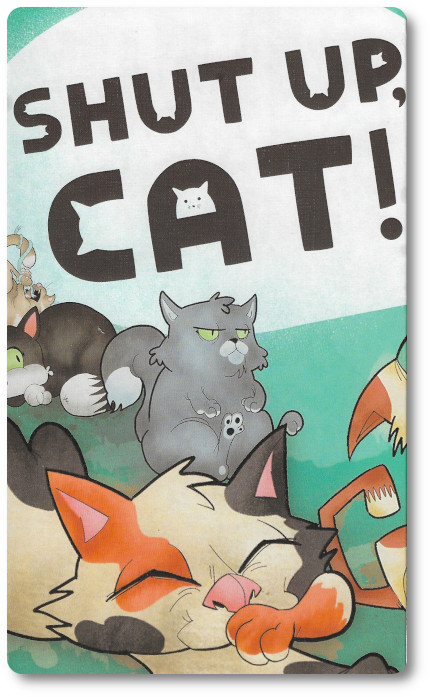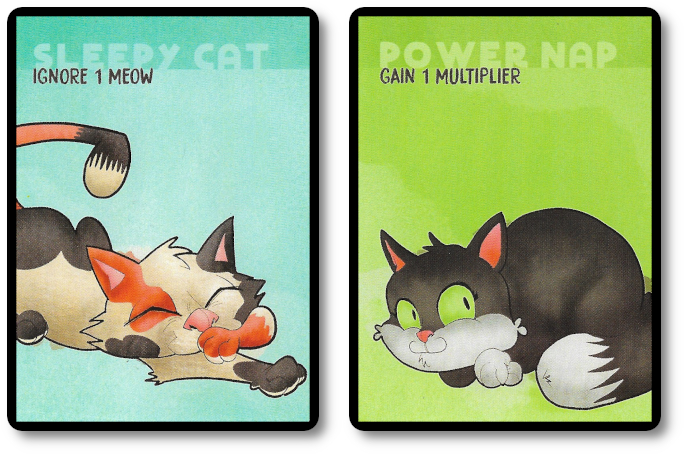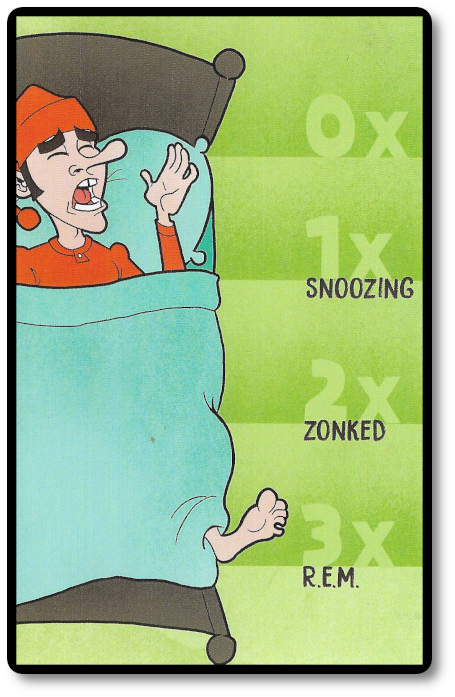Please Take Note: This review of the demo/prototype game might change slightly based on the success of the Kickstarter campaign. The game is being reviewed on the components and the rules provided with the understanding that “what you see is not what you might get” when the game is published. If you like what you read and want to learn more, we encourage you to visit the game publisher’s website or the Kickstarter campaign. Now that we have all that disclaimer junk out of the way, on with the review.
 The Basics:
The Basics:
- For ages 8 and up
- For 2 to 4 players
- Approximately 20 minutes to complete
Geek Skills:
- Counting & Math
- Logical & Critical Decision Making
- Reading
- Risk vs. Reward
- Hand/Resource Management
Learning Curve:
- Child – Easy
- Adult – Easy
Theme & Narrative:
- It’s time for bed, but that cat won’t stop making noise! SHUT THAT CAT UP!
Endorsements:
- Gamer Geek rejected!
- Parent Geek approved!
- Child Geek approved!
Overview
English humorist, satirist, and author of fantasy novels, best known for his Discworld series, Terry Pratchett said, “In ancient times cats were worshipped as gods; they have not forgotten this.” If you have ever owned a cat or even been around one for any length of time, you know that these four-legged domesticated pets have an air of superiority and a level of confidence that far outweighs their abilities. To say they are willful creatures is a gross understatement to extreme extremes. That said, they are also lovable and compassionate. In this game, the family’s beloved cat makes a lot of noise when the rest of the family attempts to sleep. Good luck trying to change the cat’s mind that it’s quiet time.
Shut Up, Cat!, designed by Wil Cox and to be published by Gravitic Games, will reportedly be comprised of one game board, 23 Distraction cards, four Player mats, four Player pawns, an unspecified number of “Z” tokens for keeping score, 12 “Sleep” tiles, and eight standard six-sided dice. As this is a review of a prepublished game, I cannot comment on the game component quality, and the number of components to be released with the game might change based on certain stretch goals. The illustrations by Jacy Otto are humorous and bright, furthering the game’s theme.
Time For Bed
To set up Shut Up, Cat!, complete the following steps.
First, place the game board in the middle of the playing area and within easy reach of all the players.
Second, shuffle the Distraction cards and place them face-down next to the game board. This is the Distraction draw deck for the duration of the game. Leave room for a discard pile.
Third, shuffle the Sleep tiles and place one face-down (so only the cat is facing up) around the game board.
Fourth, give each player a Player mat (also called a “Multiplier mat”) and a Player pawn. Have each player place their Player pawn on the “x1″ space on their Player mat.
Fifth, give each player ten”Z” tokens (also referred to as “winks”). Place the remaining “Z” tokens off to one side and in a pool for later use in the game. Place next to this pool the dice.
Sixth, not stated in the rules we were provided, but the obvious thing to do is to place the Pillow card at the center of the game board, face-up. It’s also worth noting that this card is not listed as a component, meaning it was either not added to the rules by accident or not included in the initial prototype board we were provided.
That’s it for the game setup. Determine who will go first and begin.
SOMEONE TURN THAT CAT OFF!!!
Shut Up, Cat! is played in turns with no set number of turns per game. A player’s turn is summarized here.
Step One: Gather Dice
At the start of a player’s turn, they collect three dice. If this is the game’s first turn, the first player will take these three dice from off to the side of the game board.
Optionally, the player may take one, two, or three dice from the Pillow card, keeping the value shown. They then take several dice from the pool to bring the total number of dice they now have up to three.
Regardless of how the player selects their dice, they will never have more than three to roll.
Step Two: Roll the Dice and Play Distraction Cards
The player now rolls the dice. Distraction cards can now be used during this step and before allocating their dice values.

Step Three: Allocate the Dice Values (or “Time to Make a Choice”)
The player now has one of three choices to make. Only one may be taken per turn.
Choice One: Score Points
The player now takes their dice and places two showing different numbers (“2” and “5”, for example) on their matching space on the game board. Once placed, the player flips over the Sleep tiles between the dice, including the two spaces where the dice were placed. A player may decide in which direction (clockwise or counter-clockwise from the space where the dice are placed) the tiles are flipped.
For each “Meow” revealed, the player reduces the modifier on their Player mat by one. A player may never have a multiplier lower than “zero.”
The player now scores one “Z” token for each “Z” Sleep tile revealed, multiplied by the current multiplier value on the Player mat. For example, if the player revealed five “Z” Sleep tiles and had a multiplier of “two” on their Player mat, they would collect 10 “Z” tokens. After collecting the “Z” tokens, the player picks up all the Sleep tiles revealed and rearranges them in any order they like, face-down, back to the game board.
Choice Two: Draw a Distraction Card
The player now chooses two dice with the same number value to draw one Distraction card. There is no limit to the number of Distraction cards a player may hold during the game.
Choice Three: Increase Personal Multiplier
The player now chooses two dice that add up to seven or more to increase the current multiplier value by one on the Player mat. A player’s maximum multiplier at any time is “x3”.
Step Four: Add to the Pillow
Only two dice will ever be used by the player during their turn. The two dice used to help resolve the player’s choice in step three go back to the dice pile.
The unused die goes to the Pillow card in the middle of the game board. The player now places their unused die so the value rolled matches the value shown in the space. If the die cannot be placed because another die already takes its value, the unused die is returned to the pile.
This completes the player’s turn. The next player in the turn order sequence now takes their turn, starting with step one noted above.
Increasing Multipliers During and Out of Turn
At any time, a player may turn in five “Z” tokens to increase their multiplier by one. This can be done multiple times at the cost of five “Z” tokens. For example, a player can, anytime during their turn or during an opponent’s turn, trade in 15 “Z” tokens to increase their multiplier from zero to “x3.”

Trading in “Z” tokens is referred to as “chasing the cat,” which, thematically speaking, would most certainly cause a person to lose sleep. Ever try to catch a cat who didn’t want to be caught? Near impossible. Those little felines are fast!
Winning the Game
The game continues as described above until one player has 40 or more “Z” tokens at the end of their turn.
All players now take a turn to ensure all players have the same number of turns per game.
Once everyone has had the same number of turns, players count their “Z” tokens. The player with the most “Z” tokens wins the game!
To learn more about Shut Up, Cat!, visit the game publisher’s website or the Kickstarter campaign.
Final Word
 The Child Geeks had a lot of fun playing the game, screaming, “Shut up, cat!” and “Don’t wake up the cats!” as they rolled dice and flipped tokens. Our Child Geeks easily understood the rules and how to play the game without any issues, immediately jumping into the fun. According to one Child Geek, “I really liked the funny cats and trying to make them stop making so much noise! Bad kitty!” Another Child Geek reported, “I liked the game. My cat can make noise at night, but I never lost sleep. I thought the game was fast and fun.” Regardless if the Child Geeks had cats, liked cats, or even knew what a cat sounds like at night when they don’t want to sleep, the Child Geeks all agreed the Shut Up, Cat! was worth making joyful noise about.
The Child Geeks had a lot of fun playing the game, screaming, “Shut up, cat!” and “Don’t wake up the cats!” as they rolled dice and flipped tokens. Our Child Geeks easily understood the rules and how to play the game without any issues, immediately jumping into the fun. According to one Child Geek, “I really liked the funny cats and trying to make them stop making so much noise! Bad kitty!” Another Child Geek reported, “I liked the game. My cat can make noise at night, but I never lost sleep. I thought the game was fast and fun.” Regardless if the Child Geeks had cats, liked cats, or even knew what a cat sounds like at night when they don’t want to sleep, the Child Geeks all agreed the Shut Up, Cat! was worth making joyful noise about.
 The Parent Geeks were also most pleased with the game, finding it fun to take risks, roll dice, and make empowering decisions. At all times, the Parent Geeks reported that they felt their turns were quick and the choices offered to them never felt overwhelming. Indeed, the Parent Geeks found that regardless of their dice roll, the three choices available to them – if all three were even possible – always seemed to be a good choice. According to one Parent Geek, “A fun twist on a risk-taking game that my entire family enjoyed!” Another Parent Geek stated, “A delightful game with a fun and never before seen theme. I’m not a cat lover, but I did love this game.” Whether they played with their family or peers, the Parent Geeks all agreed that Shut Up, Cat! was a lot of fun. The only negative comment we received was based on the name. Several Parent Geeks were not pleased with their Child Geeks shouting “Shut Up” loud enough for the next table to hear them. Damn embarrassing at restaurants, I’m told.
The Parent Geeks were also most pleased with the game, finding it fun to take risks, roll dice, and make empowering decisions. At all times, the Parent Geeks reported that they felt their turns were quick and the choices offered to them never felt overwhelming. Indeed, the Parent Geeks found that regardless of their dice roll, the three choices available to them – if all three were even possible – always seemed to be a good choice. According to one Parent Geek, “A fun twist on a risk-taking game that my entire family enjoyed!” Another Parent Geek stated, “A delightful game with a fun and never before seen theme. I’m not a cat lover, but I did love this game.” Whether they played with their family or peers, the Parent Geeks all agreed that Shut Up, Cat! was a lot of fun. The only negative comment we received was based on the name. Several Parent Geeks were not pleased with their Child Geeks shouting “Shut Up” loud enough for the next table to hear them. Damn embarrassing at restaurants, I’m told.
 The Gamer Geeks thought the game had some clever mechanics but found it too bland for their pallet. According to one Gamer Geek, “I think the younger and inexperienced gamers best play this game. It’s casual and fast but lacks the depth of play and strategy I look for in games. The few choices available to players are meaningful, which is good. What is not good is that they are all meaningful. Waters down the importance of my choices significantly. Without drama and consequence, I don’t enjoy the game.” Another Gamer Geek replied, “Good enough for the kids and my friends who like playing the occasional game. Not for me, though. I like games with more depth, complexity, and tactical reasoning.” The Gamer Geeks took a vote, and all decided the game was pretty good but not for them, resulting in them kicking the cat out the door.
The Gamer Geeks thought the game had some clever mechanics but found it too bland for their pallet. According to one Gamer Geek, “I think the younger and inexperienced gamers best play this game. It’s casual and fast but lacks the depth of play and strategy I look for in games. The few choices available to players are meaningful, which is good. What is not good is that they are all meaningful. Waters down the importance of my choices significantly. Without drama and consequence, I don’t enjoy the game.” Another Gamer Geek replied, “Good enough for the kids and my friends who like playing the occasional game. Not for me, though. I like games with more depth, complexity, and tactical reasoning.” The Gamer Geeks took a vote, and all decided the game was pretty good but not for them, resulting in them kicking the cat out the door.
 I fully understand where the Gamer Geeks are coming from. I found the game enjoyable when I played it with my kids and family members, but the same game fell flat with me when I played it with my gaming elitist friends. It isn’t that the game changed. Of course, the game is the same regardless of who you play it with. What changes is the value of the choices you have to make. Everyone has the same choices, which is a good idea, but all result in the same benefit. The Gamer Geeks recognized this and focused only on multiplying their scores and scoring ad nauseam. The third choice, drawing a Distraction card, was seldom used as the value it brought – while important – didn’t win the game in the long run.
I fully understand where the Gamer Geeks are coming from. I found the game enjoyable when I played it with my kids and family members, but the same game fell flat with me when I played it with my gaming elitist friends. It isn’t that the game changed. Of course, the game is the same regardless of who you play it with. What changes is the value of the choices you have to make. Everyone has the same choices, which is a good idea, but all result in the same benefit. The Gamer Geeks recognized this and focused only on multiplying their scores and scoring ad nauseam. The third choice, drawing a Distraction card, was seldom used as the value it brought – while important – didn’t win the game in the long run.
Let me put it another way. Shut Up, Cat! is being positioned as a “push-your-luck” style of game. This means there should be some consequence if you push said luck too hard. There isn’t that level of “whoops, I pushed too much” to be found in Shut Up, Cats! Not a bad thing, but the need for a negative result based on actions selected and choices made other than not having more points than the other player at the moment wasn’t enough for our elitist players who need that kind of excitement.
This is not to say that the Game Geeks broke the game, far from it. Their style of play is always rather cutthroat and focused on winning as big as possible. I never thought the game was trying to force the players to outpace each other with points. The ability to sell points back to increase your modifier was a pretty big giveaway that the game designer wanted players to be in the game for as long as they liked and have the ability to catch up if they felt left behind.
The result is a game that didn’t entice the Gamer Geeks but greatly enthused everyone else. This is a pretty big “win” in my book, especially when Child Geeks want to do nothing more than play games with their friends and family. Look at this game and get it to your table when time allows. If your family and friends are like mine – excluding your gaming elitist friends – they’ll have a howling good time.
This is a paid-for review of the game’s final prototype. Although our time and focus were financially compensated, our words are our own. We’d need at least 10 million dollars before we started saying what other people wanted. Such is the statuesque and legendary integrity of Father Geek, which cannot be bought except by those who own their private islands and small countries.



